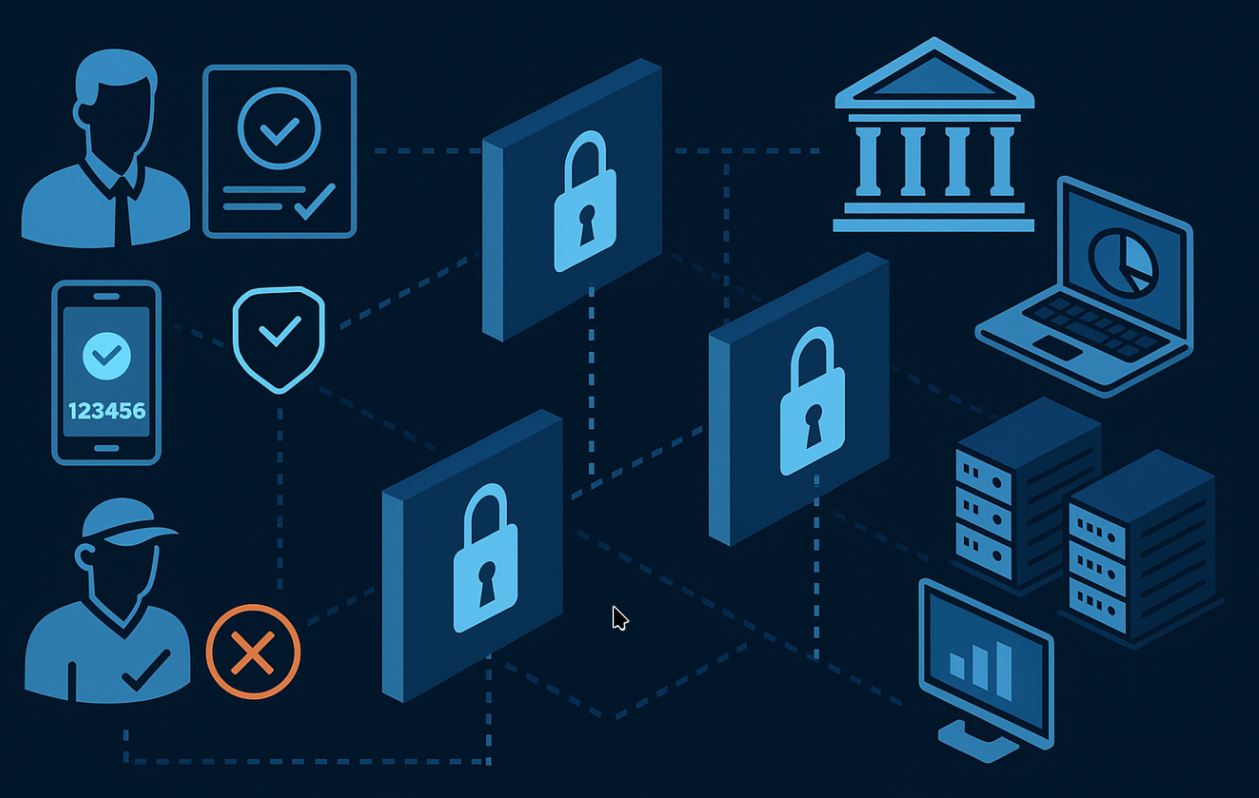Zero Trust infrastructure is essential in financial services due to the sensitivity and high value of financial data, making it a prime target for cybercriminals.
As digital transformation accelerates and remote working arrangements become commonplace, traditional security perimeters are rapidly becoming obsolete. Financial institutions must adapt to this new reality, where threats can originate from both external and internal sources. This shift in the threat landscape underscores the necessity of adopting a robust Zero Trust security model, a foundational approach to protecting consumer data and ensuring regulatory compliance.
At Fund Guardian, our work involves designing and implementing secure, scalable, and resilient IT infrastructure that supports regulatory compliance and fosters digital sovereignty. Zero Trust architecture aligns seamlessly with these objectives, emphasizing continuous verification and minimizing the implicit trust traditionally placed within internal networks.
One of the critical principles of Zero Trust is that it operates on the premise of “never trust, always verify.” Every user, device, and transaction is continuously authenticated and authorized, irrespective of their location. This contrasts sharply with legacy security models, where entities inside the network perimeter were often implicitly trusted, potentially opening the door for malicious actors to exploit vulnerabilities from within.
Financial services are particularly vulnerable because consumers inherently expect their financial data to remain secure. This expectation is reinforced by stringent regulatory frameworks such as GDPR and PSD2, which mandate strict security protocols to protect personal and financial information. Adopting a Zero Trust model ensures that financial institutions not only meet these compliance requirements but also demonstrate their commitment to data security to both regulators and consumers.
Recent statistics underline the necessity of this approach. In 2021 alone, the financial sector faced 690 confirmed data disclosures, with an alarming 93% of breaches driven by financial gain. These incidents highlight the aggressive targeting of financial institutions, reinforcing the critical importance of robust and proactive cybersecurity measures. By implementing Zero Trust infrastructure, financial organizations significantly mitigate risks associated with data breaches and unauthorized access through rigorous access control mechanisms.
Financial Impact of Data Breaches
2024: IBM reported the global average cost of a data breach reached $4.88 million, a 10% increase over the previous year.
2023: The Identity Theft Resource Center (ITRC) reported a record 3,205 data compromises, marking a 78% increase from 2022 and a 72% rise over the previous high in 2021.
2022: Verizon‘s Data Breach Investigations Report (DBIR) analyzed 23,896 security incidents, with 5,212 confirmed data breaches. In the financial services sector, the average breach cost was $5.9 million, slightly down from $5.97 million in 2022.
2021: The financial sector experienced 690 confirmed data disclosures, with 93% of breaches driven by financial gain. The average cost of a data breach for financial firms was $5.72 million.
Common Causes and Threat Vectors
- Human Error: In 2024, 68% of data breaches involved human errors, such as falling for phishing scams.
- Cloud Environments: 40% of breaches involved data stored across multiple environments, with breached data in public clouds incurring the highest average cost at $5.17 million.
- Ransomware Attacks: As reported by Financial Times, In 2023, 64% of financial services organizations reported ransomware attacks, up from 55% in 2022.
Financial Sector Specifics
- Targeted Attacks: The financial sector is a prime target for cybercriminals, with firms being 300 times more likely to experience cyberattacks compared to other industries. Investopedia
- Regulatory Compliance: As reported by Accutivesecurity, Financial institutions face overlapping regulations such as GLBA, PCI DSS, SOX, and NYDFS, with breaches potentially resulting in fines up to $100,000 per violation under GLBA.
Enter Zero Trust
A central element of Zero Trust is micro-segmentation, a technique that divides networks into smaller, isolated segments, each secured independently. This segmentation limits the scope of any potential breach, containing it within a manageable area and significantly reducing its potential impact. At Fund Guardian, implementing micro-segmentation is fundamental in architecting infrastructures that can effectively respond to threats while maintaining business continuity and protecting critical assets.

Identity and Access Management (IAM) is another critical aspect of the Zero Trust architecture. IAM ensures that access to resources and data is strictly controlled based on verified identities, typically employing advanced security measures such as multifactor authentication (MFA) and biometric verification. These methods offer superior protection by validating users’ identities more rigorously than traditional username-password models. As a Solution Architect, my work includes integrating these IAM solutions seamlessly into our infrastructure to ensure a smooth user experience without compromising on security.
Zero Trust architecture supports detailed logging and analytics, enabling proactive threat detection and real-time responses to potential security incidents. These analytical capabilities are vital for financial services organizations, where detecting and responding swiftly to threats can prevent significant financial loss and reputational damage.
Implementing Zero Trust also enhances an organization’s overall security posture, providing greater resilience against emerging threats and rapidly changing security landscapes. This flexibility and adaptability are crucial as financial institutions continue to innovate and expand their digital services.
Adopting a Zero Trust security model is not merely advisable -but necessary- for financial services organizations aiming to protect sensitive financial data, comply with stringent regulatory requirements, and maintain consumer trust. At Fund Guardian, we are committed in harnessing the full potential of Zero Trust principles to build secure, compliant, and resilient infrastructures that stand firm against evolving cybersecurity threats, safeguarding both our clients and their customers.